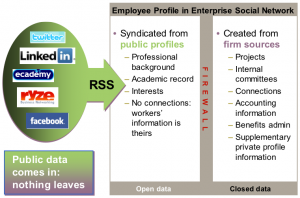 The Social Network Roadmap is a disciplined approach for adopting social networks and Web 2.0, but in 2008 executives always ask me, “Why should we be interested in this? Of course, there’s a lot of noise about it, but how is it beyond hype?” That’s fair enough, and the first part of my presentation at the Social Networking Conference last month dealt with drivers from corporate and people perspectives that drive the demand for cross-boundary social networks. Here we’ll delve into what’s driving demand and symptoms you can use to guide your strategy.
The Social Network Roadmap is a disciplined approach for adopting social networks and Web 2.0, but in 2008 executives always ask me, “Why should we be interested in this? Of course, there’s a lot of noise about it, but how is it beyond hype?” That’s fair enough, and the first part of my presentation at the Social Networking Conference last month dealt with drivers from corporate and people perspectives that drive the demand for cross-boundary social networks. Here we’ll delve into what’s driving demand and symptoms you can use to guide your strategy.
Enterprise Drivers
Corporations are on the verge of crisis. As I wrote in The Transformation Imperative, most large organizations have been built on Industrial Economy assumptions, one of which is adding value by creating economies of scale (efficiency, lower prices) in many aspects of business process. The ability to lower costs by mandating processes has been the bedrock of organizational value for the past 200 years. The Knowledge Economy’s infrastructure is IT, and its latest iteration is Web 2.0, which is driving down transaction costs for everyone online. In other words, you don’t have to be inside a corporation to get low costs; locating what you want or who you need is becoming very easy online.
Low costs no longer differentiate. They are merely expected.
Meanwhile, customers are getting increasingly accustomed to being addressed as individuals online. Mass marketing makes less impact every passing month. But “the crowd online” is frequently more targeted, if not more personal. People exchange information about everything; they discover and consume novelty very quickly, so it remains novel for a nanosecond. The experience around (the product) is increasingly more important than the product. You can have a functional purse, but a Bottega Veneta bag will impress, adding to your experience value-add, especially if someone mentions it in her blog. Increasingly, people online create experience together. Comments are getting to be more important than the original content.
The Bottom Line: Innovation and Cross-boundary Collaboration
Since industrial efficiency is assumed, organizations must look elsewhere. Loosely, innovation means creating practical novelty according to a process. But processes aren’t set up for change; they have created value from exacting controls. Companies have traditionally been poor innovators because they haven’t valued discontinuous change. They have to change. Listen in on some quotes from two 2008 surveys conducted by IBM (CEO and Human Capital):
- Corporations will be increasingly challenged because their processes and people are not capable of responding to change quickly enough
- Enterprises do not understand the importance of cross-boundary collaboration
- The half-life of knowledge is less than two years on average
- Global enterprises have extensive resources, but they are largely ineffective at accessing them. Real decisions are made by “who knows whom” and “anecdotal information
What organizations need is cross-boundary collaboration, and the world is rapidly evolving to a global expertise network. With an email, mobile number and LinkedIn profile, everybody’s open for business. Companies used to lower transaction costs through their global employee directories. Now everyone has one, and LinkedIn is better than almost any corporate directory. If you need an expert on transfer pricing in the injection molding industry, does it really matter whether she works for your company? In many cases, it matters more that she’s addressable from within your workstream, and there’s no conflict of interest.
There are always more smart people outside than inside.
Corporations will crack the innovation nut by enabling employees to source expertise whenever and wherever they need. Obviously, employees need coaching, guidance and boundaries for how to do this, but companies who crack the nut will outperform others.
White Water for Individuals
Likewise, employees are in a period of tumult. People are free agents by default; most C-level jobs average less than two years. People are required to do more with less, and survival means hitting the ground running. Social safety nets are fraying fast. In the US, many models have Medicare and Social Security bankrupt within decades. Medical insurance is increasingly the employee’s responsibility. Formerly “solid” jobs are sourced worldwide. New jobs are, well, new, they require really new thinking.
Professional (digital) social networks are the individual’s key to performance because each person carries his/her portable expertise network wherever s/he goes. With digital networks, people can create and manage larger networks of people who can help them execute quickly and get new work.
Conclusion: Digital Social Networks Are Win-Win for Firms and People
Companies and people need to perform better by collaborating more. Social networks are key enablers of cross-boundary collaboration. It’s key to leverage internal and external information to create the most value.
 Regarding profile (i.e. LinkedIn, Facebook, Xing) information, external information will always be superior to internal because it is multi-purpose for the individual, who is more motivated to maintain it and expand it. Therefore, CTOs should think about invoking external profile information internally (see right).
Regarding profile (i.e. LinkedIn, Facebook, Xing) information, external information will always be superior to internal because it is multi-purpose for the individual, who is more motivated to maintain it and expand it. Therefore, CTOs should think about invoking external profile information internally (see right).
In the next session, we discussed who would end up fulfilling the “enterprise social network” need: enterprise vendors like Lotus Connections or consumer-oriented sites like LinkedIn.

Leave a Reply
You must be logged in to post a comment.